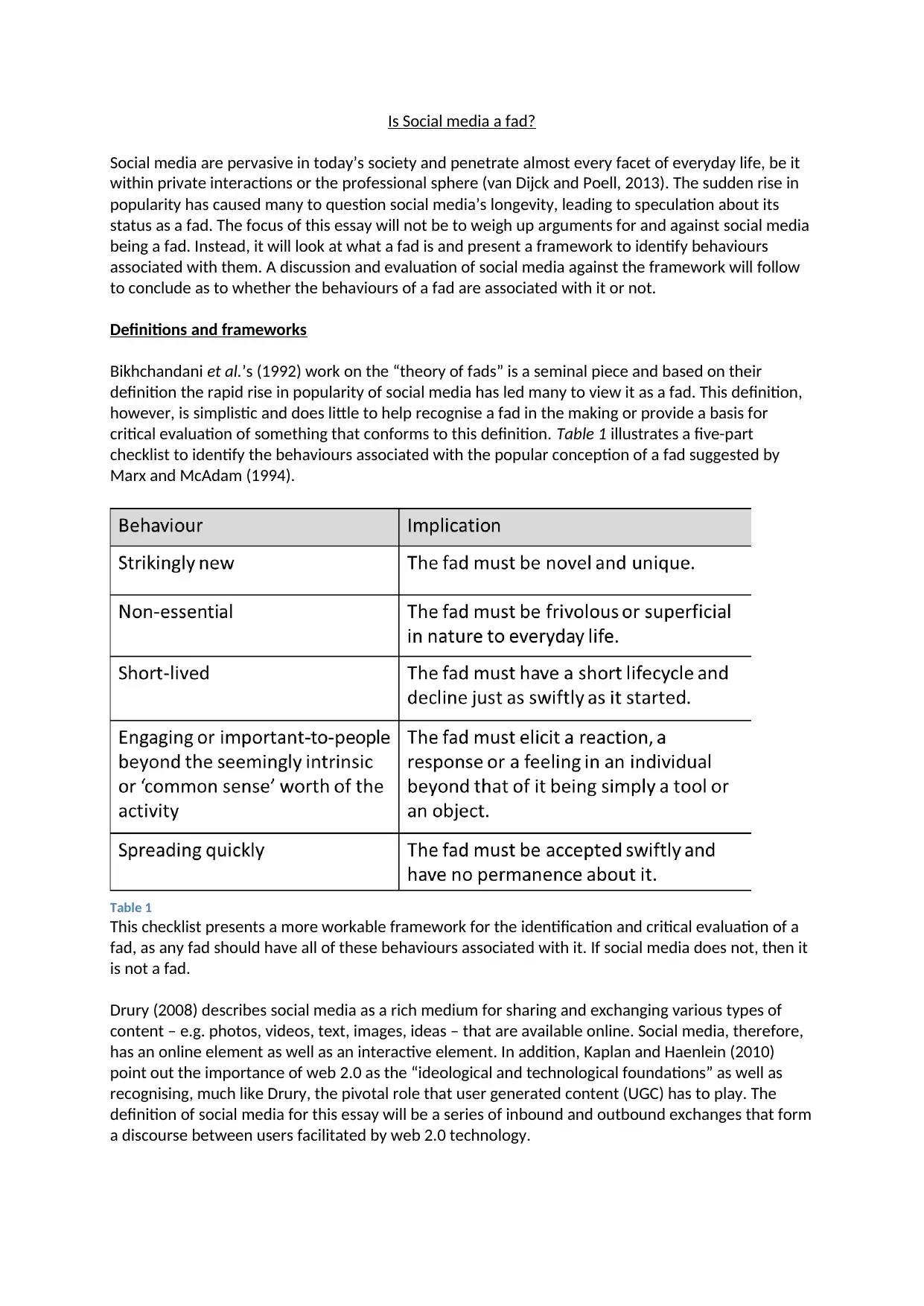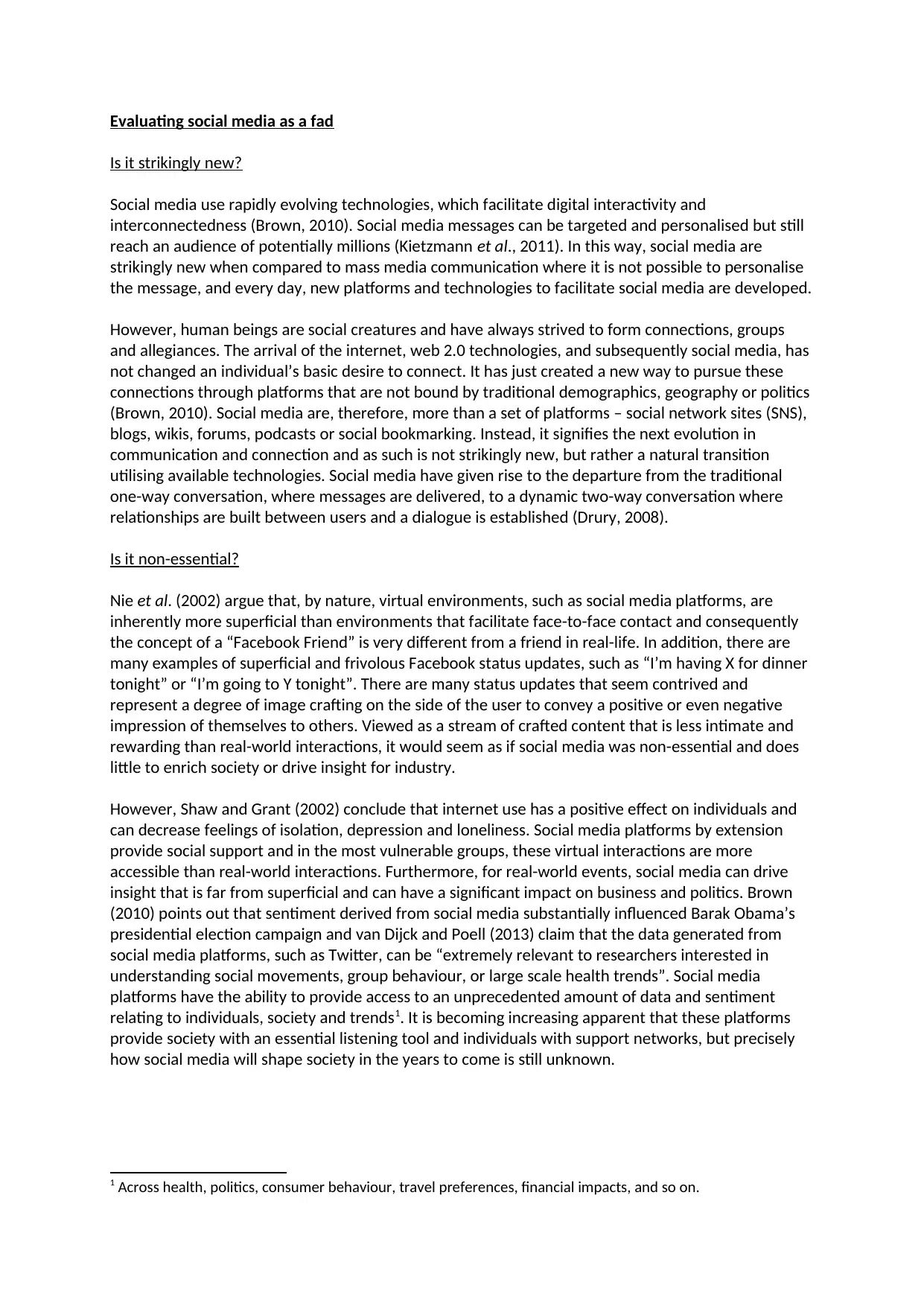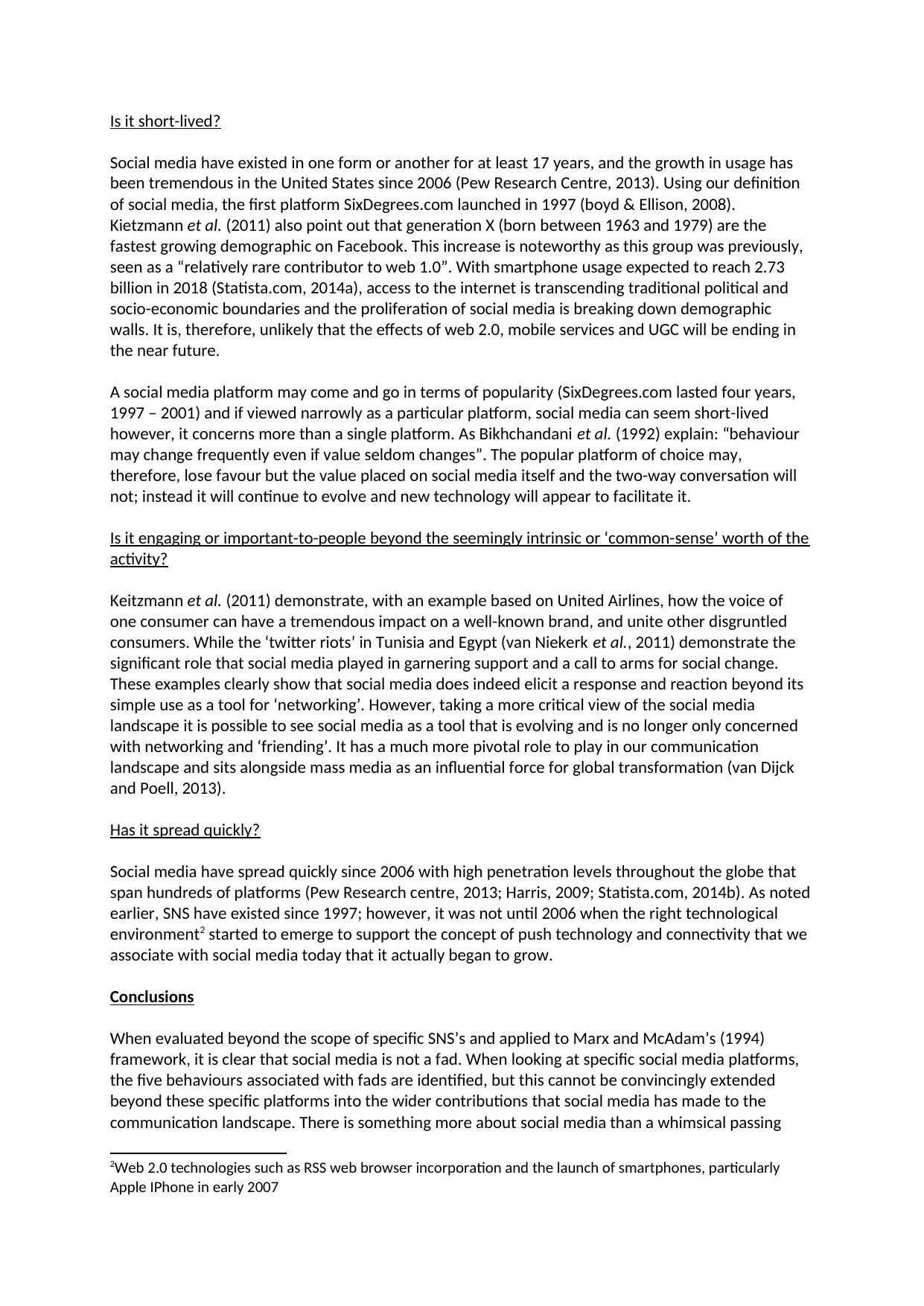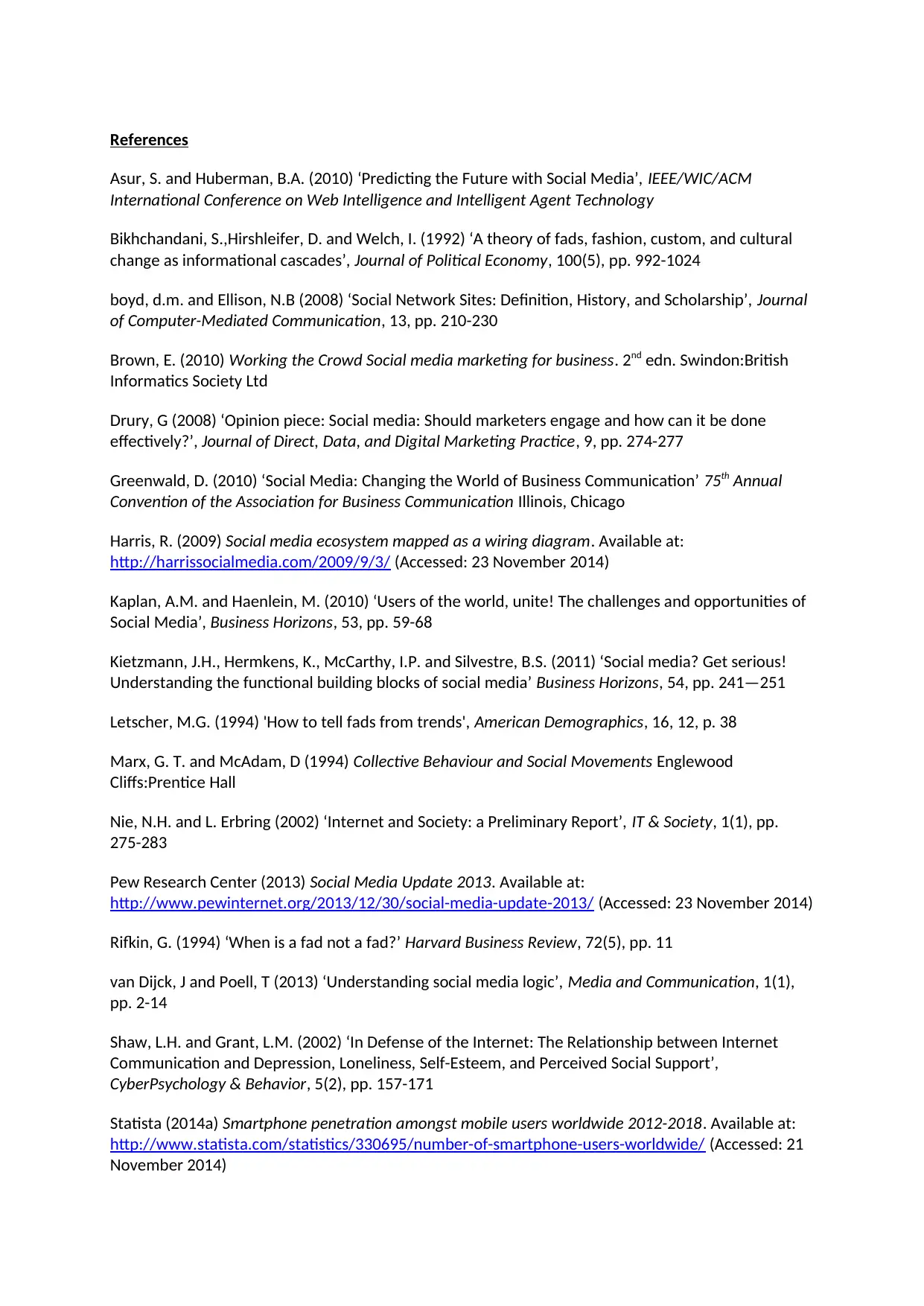Essay On The Influence Of Social Media On Politics
VerifiedAdded on 2022/01/18
|6
|2546
|48
AI Summary
Contribute Materials
Your contribution can guide someone’s learning journey. Share your
documents today.

Is Social media a fad?
Social media are pervasive in today’s society and penetrate almost every facet of everyday life, be it
within private interactions or the professional sphere (van Dijck and Poell, 2013). The sudden rise in
popularity has caused many to question social media’s longevity, leading to speculation about its
status as a fad. The focus of this essay will not be to weigh up arguments for and against social media
being a fad. Instead, it will look at what a fad is and present a framework to identify behaviours
associated with them. A discussion and evaluation of social media against the framework will follow
to conclude as to whether the behaviours of a fad are associated with it or not.
Definitions and frameworks
Bikhchandani et al.’s (1992) work on the “theory of fads” is a seminal piece and based on their
definition the rapid rise in popularity of social media has led many to view it as a fad. This definition,
however, is simplistic and does little to help recognise a fad in the making or provide a basis for
critical evaluation of something that conforms to this definition. Table 1 illustrates a five-part
checklist to identify the behaviours associated with the popular conception of a fad suggested by
Marx and McAdam (1994).
Table 1
This checklist presents a more workable framework for the identification and critical evaluation of a
fad, as any fad should have all of these behaviours associated with it. If social media does not, then it
is not a fad.
Drury (2008) describes social media as a rich medium for sharing and exchanging various types of
content – e.g. photos, videos, text, images, ideas – that are available online. Social media, therefore,
has an online element as well as an interactive element. In addition, Kaplan and Haenlein (2010)
point out the importance of web 2.0 as the “ideological and technological foundations” as well as
recognising, much like Drury, the pivotal role that user generated content (UGC) has to play. The
definition of social media for this essay will be a series of inbound and outbound exchanges that form
a discourse between users facilitated by web 2.0 technology.
Social media are pervasive in today’s society and penetrate almost every facet of everyday life, be it
within private interactions or the professional sphere (van Dijck and Poell, 2013). The sudden rise in
popularity has caused many to question social media’s longevity, leading to speculation about its
status as a fad. The focus of this essay will not be to weigh up arguments for and against social media
being a fad. Instead, it will look at what a fad is and present a framework to identify behaviours
associated with them. A discussion and evaluation of social media against the framework will follow
to conclude as to whether the behaviours of a fad are associated with it or not.
Definitions and frameworks
Bikhchandani et al.’s (1992) work on the “theory of fads” is a seminal piece and based on their
definition the rapid rise in popularity of social media has led many to view it as a fad. This definition,
however, is simplistic and does little to help recognise a fad in the making or provide a basis for
critical evaluation of something that conforms to this definition. Table 1 illustrates a five-part
checklist to identify the behaviours associated with the popular conception of a fad suggested by
Marx and McAdam (1994).
Table 1
This checklist presents a more workable framework for the identification and critical evaluation of a
fad, as any fad should have all of these behaviours associated with it. If social media does not, then it
is not a fad.
Drury (2008) describes social media as a rich medium for sharing and exchanging various types of
content – e.g. photos, videos, text, images, ideas – that are available online. Social media, therefore,
has an online element as well as an interactive element. In addition, Kaplan and Haenlein (2010)
point out the importance of web 2.0 as the “ideological and technological foundations” as well as
recognising, much like Drury, the pivotal role that user generated content (UGC) has to play. The
definition of social media for this essay will be a series of inbound and outbound exchanges that form
a discourse between users facilitated by web 2.0 technology.
Secure Best Marks with AI Grader
Need help grading? Try our AI Grader for instant feedback on your assignments.

Evaluating social media as a fad
Is it strikingly new?
Social media use rapidly evolving technologies, which facilitate digital interactivity and
interconnectedness (Brown, 2010). Social media messages can be targeted and personalised but still
reach an audience of potentially millions (Kietzmann et al., 2011). In this way, social media are
strikingly new when compared to mass media communication where it is not possible to personalise
the message, and every day, new platforms and technologies to facilitate social media are developed.
However, human beings are social creatures and have always strived to form connections, groups
and allegiances. The arrival of the internet, web 2.0 technologies, and subsequently social media, has
not changed an individual’s basic desire to connect. It has just created a new way to pursue these
connections through platforms that are not bound by traditional demographics, geography or politics
(Brown, 2010). Social media are, therefore, more than a set of platforms – social network sites (SNS),
blogs, wikis, forums, podcasts or social bookmarking. Instead, it signifies the next evolution in
communication and connection and as such is not strikingly new, but rather a natural transition
utilising available technologies. Social media have given rise to the departure from the traditional
one-way conversation, where messages are delivered, to a dynamic two-way conversation where
relationships are built between users and a dialogue is established (Drury, 2008).
Is it non-essential?
Nie et al. (2002) argue that, by nature, virtual environments, such as social media platforms, are
inherently more superficial than environments that facilitate face-to-face contact and consequently
the concept of a “Facebook Friend” is very different from a friend in real-life. In addition, there are
many examples of superficial and frivolous Facebook status updates, such as “I’m having X for dinner
tonight” or “I’m going to Y tonight”. There are many status updates that seem contrived and
represent a degree of image crafting on the side of the user to convey a positive or even negative
impression of themselves to others. Viewed as a stream of crafted content that is less intimate and
rewarding than real-world interactions, it would seem as if social media was non-essential and does
little to enrich society or drive insight for industry.
However, Shaw and Grant (2002) conclude that internet use has a positive effect on individuals and
can decrease feelings of isolation, depression and loneliness. Social media platforms by extension
provide social support and in the most vulnerable groups, these virtual interactions are more
accessible than real-world interactions. Furthermore, for real-world events, social media can drive
insight that is far from superficial and can have a significant impact on business and politics. Brown
(2010) points out that sentiment derived from social media substantially influenced Barak Obama’s
presidential election campaign and van Dijck and Poell (2013) claim that the data generated from
social media platforms, such as Twitter, can be “extremely relevant to researchers interested in
understanding social movements, group behaviour, or large scale health trends”. Social media
platforms have the ability to provide access to an unprecedented amount of data and sentiment
relating to individuals, society and trends1. It is becoming increasing apparent that these platforms
provide society with an essential listening tool and individuals with support networks, but precisely
how social media will shape society in the years to come is still unknown.
1 Across health, politics, consumer behaviour, travel preferences, financial impacts, and so on.
Is it strikingly new?
Social media use rapidly evolving technologies, which facilitate digital interactivity and
interconnectedness (Brown, 2010). Social media messages can be targeted and personalised but still
reach an audience of potentially millions (Kietzmann et al., 2011). In this way, social media are
strikingly new when compared to mass media communication where it is not possible to personalise
the message, and every day, new platforms and technologies to facilitate social media are developed.
However, human beings are social creatures and have always strived to form connections, groups
and allegiances. The arrival of the internet, web 2.0 technologies, and subsequently social media, has
not changed an individual’s basic desire to connect. It has just created a new way to pursue these
connections through platforms that are not bound by traditional demographics, geography or politics
(Brown, 2010). Social media are, therefore, more than a set of platforms – social network sites (SNS),
blogs, wikis, forums, podcasts or social bookmarking. Instead, it signifies the next evolution in
communication and connection and as such is not strikingly new, but rather a natural transition
utilising available technologies. Social media have given rise to the departure from the traditional
one-way conversation, where messages are delivered, to a dynamic two-way conversation where
relationships are built between users and a dialogue is established (Drury, 2008).
Is it non-essential?
Nie et al. (2002) argue that, by nature, virtual environments, such as social media platforms, are
inherently more superficial than environments that facilitate face-to-face contact and consequently
the concept of a “Facebook Friend” is very different from a friend in real-life. In addition, there are
many examples of superficial and frivolous Facebook status updates, such as “I’m having X for dinner
tonight” or “I’m going to Y tonight”. There are many status updates that seem contrived and
represent a degree of image crafting on the side of the user to convey a positive or even negative
impression of themselves to others. Viewed as a stream of crafted content that is less intimate and
rewarding than real-world interactions, it would seem as if social media was non-essential and does
little to enrich society or drive insight for industry.
However, Shaw and Grant (2002) conclude that internet use has a positive effect on individuals and
can decrease feelings of isolation, depression and loneliness. Social media platforms by extension
provide social support and in the most vulnerable groups, these virtual interactions are more
accessible than real-world interactions. Furthermore, for real-world events, social media can drive
insight that is far from superficial and can have a significant impact on business and politics. Brown
(2010) points out that sentiment derived from social media substantially influenced Barak Obama’s
presidential election campaign and van Dijck and Poell (2013) claim that the data generated from
social media platforms, such as Twitter, can be “extremely relevant to researchers interested in
understanding social movements, group behaviour, or large scale health trends”. Social media
platforms have the ability to provide access to an unprecedented amount of data and sentiment
relating to individuals, society and trends1. It is becoming increasing apparent that these platforms
provide society with an essential listening tool and individuals with support networks, but precisely
how social media will shape society in the years to come is still unknown.
1 Across health, politics, consumer behaviour, travel preferences, financial impacts, and so on.

Is it short-lived?
Social media have existed in one form or another for at least 17 years, and the growth in usage has
been tremendous in the United States since 2006 (Pew Research Centre, 2013). Using our definition
of social media, the first platform SixDegrees.com launched in 1997 (boyd & Ellison, 2008).
Kietzmann et al. (2011) also point out that generation X (born between 1963 and 1979) are the
fastest growing demographic on Facebook. This increase is noteworthy as this group was previously,
seen as a “relatively rare contributor to web 1.0”. With smartphone usage expected to reach 2.73
billion in 2018 (Statista.com, 2014a), access to the internet is transcending traditional political and
socio-economic boundaries and the proliferation of social media is breaking down demographic
walls. It is, therefore, unlikely that the effects of web 2.0, mobile services and UGC will be ending in
the near future.
A social media platform may come and go in terms of popularity (SixDegrees.com lasted four years,
1997 – 2001) and if viewed narrowly as a particular platform, social media can seem short-lived
however, it concerns more than a single platform. As Bikhchandani et al. (1992) explain: “behaviour
may change frequently even if value seldom changes”. The popular platform of choice may,
therefore, lose favour but the value placed on social media itself and the two-way conversation will
not; instead it will continue to evolve and new technology will appear to facilitate it.
Is it engaging or important-to-people beyond the seemingly intrinsic or ‘common-sense’ worth of the
activity?
Keitzmann et al. (2011) demonstrate, with an example based on United Airlines, how the voice of
one consumer can have a tremendous impact on a well-known brand, and unite other disgruntled
consumers. While the ‘twitter riots’ in Tunisia and Egypt (van Niekerk et al., 2011) demonstrate the
significant role that social media played in garnering support and a call to arms for social change.
These examples clearly show that social media does indeed elicit a response and reaction beyond its
simple use as a tool for ‘networking’. However, taking a more critical view of the social media
landscape it is possible to see social media as a tool that is evolving and is no longer only concerned
with networking and ‘friending’. It has a much more pivotal role to play in our communication
landscape and sits alongside mass media as an influential force for global transformation (van Dijck
and Poell, 2013).
Has it spread quickly?
Social media have spread quickly since 2006 with high penetration levels throughout the globe that
span hundreds of platforms (Pew Research centre, 2013; Harris, 2009; Statista.com, 2014b). As noted
earlier, SNS have existed since 1997; however, it was not until 2006 when the right technological
environment2 started to emerge to support the concept of push technology and connectivity that we
associate with social media today that it actually began to grow.
Conclusions
When evaluated beyond the scope of specific SNS’s and applied to Marx and McAdam’s (1994)
framework, it is clear that social media is not a fad. When looking at specific social media platforms,
the five behaviours associated with fads are identified, but this cannot be convincingly extended
beyond these specific platforms into the wider contributions that social media has made to the
communication landscape. There is something more about social media than a whimsical passing
2Web 2.0 technologies such as RSS web browser incorporation and the launch of smartphones, particularly
Apple IPhone in early 2007
Social media have existed in one form or another for at least 17 years, and the growth in usage has
been tremendous in the United States since 2006 (Pew Research Centre, 2013). Using our definition
of social media, the first platform SixDegrees.com launched in 1997 (boyd & Ellison, 2008).
Kietzmann et al. (2011) also point out that generation X (born between 1963 and 1979) are the
fastest growing demographic on Facebook. This increase is noteworthy as this group was previously,
seen as a “relatively rare contributor to web 1.0”. With smartphone usage expected to reach 2.73
billion in 2018 (Statista.com, 2014a), access to the internet is transcending traditional political and
socio-economic boundaries and the proliferation of social media is breaking down demographic
walls. It is, therefore, unlikely that the effects of web 2.0, mobile services and UGC will be ending in
the near future.
A social media platform may come and go in terms of popularity (SixDegrees.com lasted four years,
1997 – 2001) and if viewed narrowly as a particular platform, social media can seem short-lived
however, it concerns more than a single platform. As Bikhchandani et al. (1992) explain: “behaviour
may change frequently even if value seldom changes”. The popular platform of choice may,
therefore, lose favour but the value placed on social media itself and the two-way conversation will
not; instead it will continue to evolve and new technology will appear to facilitate it.
Is it engaging or important-to-people beyond the seemingly intrinsic or ‘common-sense’ worth of the
activity?
Keitzmann et al. (2011) demonstrate, with an example based on United Airlines, how the voice of
one consumer can have a tremendous impact on a well-known brand, and unite other disgruntled
consumers. While the ‘twitter riots’ in Tunisia and Egypt (van Niekerk et al., 2011) demonstrate the
significant role that social media played in garnering support and a call to arms for social change.
These examples clearly show that social media does indeed elicit a response and reaction beyond its
simple use as a tool for ‘networking’. However, taking a more critical view of the social media
landscape it is possible to see social media as a tool that is evolving and is no longer only concerned
with networking and ‘friending’. It has a much more pivotal role to play in our communication
landscape and sits alongside mass media as an influential force for global transformation (van Dijck
and Poell, 2013).
Has it spread quickly?
Social media have spread quickly since 2006 with high penetration levels throughout the globe that
span hundreds of platforms (Pew Research centre, 2013; Harris, 2009; Statista.com, 2014b). As noted
earlier, SNS have existed since 1997; however, it was not until 2006 when the right technological
environment2 started to emerge to support the concept of push technology and connectivity that we
associate with social media today that it actually began to grow.
Conclusions
When evaluated beyond the scope of specific SNS’s and applied to Marx and McAdam’s (1994)
framework, it is clear that social media is not a fad. When looking at specific social media platforms,
the five behaviours associated with fads are identified, but this cannot be convincingly extended
beyond these specific platforms into the wider contributions that social media has made to the
communication landscape. There is something more about social media than a whimsical passing
2Web 2.0 technologies such as RSS web browser incorporation and the launch of smartphones, particularly
Apple IPhone in early 2007

fancy. It is likely that those that think of social media as a fad probably misunderstand what social
media are (Kaplan and Haenlein, 2010) and view it as a set of platforms rather than a means of
communication with wide reaching ramifications.
It’s hard to see the impact that social media will have on society, now and in the future, but it is safe
to say that it has taken a place alongside mass media as another communication tool and, although it
could be thought to have started as a fad, it has transcended into something more. Letscher (1994)
argued that it is possible for a fad to evolve and become a trend; Rifkin (1994) built on this to suggest
that once trends become embedded in society and part of daily operations that trends become
“collective wisdom”. It would be fair to say that social media in 2014 has indeed become embedded
in society and part of the fabric of communication across all facets of society and industry; as such it
is now collective wisdom and has manifested a sense of permanence with its high level of
penetration.
media are (Kaplan and Haenlein, 2010) and view it as a set of platforms rather than a means of
communication with wide reaching ramifications.
It’s hard to see the impact that social media will have on society, now and in the future, but it is safe
to say that it has taken a place alongside mass media as another communication tool and, although it
could be thought to have started as a fad, it has transcended into something more. Letscher (1994)
argued that it is possible for a fad to evolve and become a trend; Rifkin (1994) built on this to suggest
that once trends become embedded in society and part of daily operations that trends become
“collective wisdom”. It would be fair to say that social media in 2014 has indeed become embedded
in society and part of the fabric of communication across all facets of society and industry; as such it
is now collective wisdom and has manifested a sense of permanence with its high level of
penetration.
Secure Best Marks with AI Grader
Need help grading? Try our AI Grader for instant feedback on your assignments.

References
Asur, S. and Huberman, B.A. (2010) ‘Predicting the Future with Social Media’, IEEE/WIC/ACM
International Conference on Web Intelligence and Intelligent Agent Technology
Bikhchandani, S.,Hirshleifer, D. and Welch, I. (1992) ‘A theory of fads, fashion, custom, and cultural
change as informational cascades’, Journal of Political Economy, 100(5), pp. 992-1024
boyd, d.m. and Ellison, N.B (2008) ‘Social Network Sites: Definition, History, and Scholarship’, Journal
of Computer-Mediated Communication, 13, pp. 210-230
Brown, E. (2010) Working the Crowd Social media marketing for business. 2nd edn. Swindon:British
Informatics Society Ltd
Drury, G (2008) ‘Opinion piece: Social media: Should marketers engage and how can it be done
effectively?’, Journal of Direct, Data, and Digital Marketing Practice, 9, pp. 274-277
Greenwald, D. (2010) ‘Social Media: Changing the World of Business Communication’ 75th Annual
Convention of the Association for Business Communication Illinois, Chicago
Harris, R. (2009) Social media ecosystem mapped as a wiring diagram. Available at:
http://harrissocialmedia.com/2009/9/3/ (Accessed: 23 November 2014)
Kaplan, A.M. and Haenlein, M. (2010) ‘Users of the world, unite! The challenges and opportunities of
Social Media’, Business Horizons, 53, pp. 59-68
Kietzmann, J.H., Hermkens, K., McCarthy, I.P. and Silvestre, B.S. (2011) ‘Social media? Get serious!
Understanding the functional building blocks of social media’ Business Horizons, 54, pp. 241—251
Letscher, M.G. (1994) 'How to tell fads from trends', American Demographics, 16, 12, p. 38
Marx, G. T. and McAdam, D (1994) Collective Behaviour and Social Movements Englewood
Cliffs:Prentice Hall
Nie, N.H. and L. Erbring (2002) ‘Internet and Society: a Preliminary Report’, IT & Society, 1(1), pp.
275-283
Pew Research Center (2013) Social Media Update 2013. Available at:
http://www.pewinternet.org/2013/12/30/social-media-update-2013/ (Accessed: 23 November 2014)
Rifkin, G. (1994) ‘When is a fad not a fad?’ Harvard Business Review, 72(5), pp. 11
van Dijck, J and Poell, T (2013) ‘Understanding social media logic’, Media and Communication, 1(1),
pp. 2-14
Shaw, L.H. and Grant, L.M. (2002) ‘In Defense of the Internet: The Relationship between Internet
Communication and Depression, Loneliness, Self-Esteem, and Perceived Social Support’,
CyberPsychology & Behavior, 5(2), pp. 157-171
Statista (2014a) Smartphone penetration amongst mobile users worldwide 2012-2018. Available at:
http://www.statista.com/statistics/330695/number-of-smartphone-users-worldwide/ (Accessed: 21
November 2014)
Asur, S. and Huberman, B.A. (2010) ‘Predicting the Future with Social Media’, IEEE/WIC/ACM
International Conference on Web Intelligence and Intelligent Agent Technology
Bikhchandani, S.,Hirshleifer, D. and Welch, I. (1992) ‘A theory of fads, fashion, custom, and cultural
change as informational cascades’, Journal of Political Economy, 100(5), pp. 992-1024
boyd, d.m. and Ellison, N.B (2008) ‘Social Network Sites: Definition, History, and Scholarship’, Journal
of Computer-Mediated Communication, 13, pp. 210-230
Brown, E. (2010) Working the Crowd Social media marketing for business. 2nd edn. Swindon:British
Informatics Society Ltd
Drury, G (2008) ‘Opinion piece: Social media: Should marketers engage and how can it be done
effectively?’, Journal of Direct, Data, and Digital Marketing Practice, 9, pp. 274-277
Greenwald, D. (2010) ‘Social Media: Changing the World of Business Communication’ 75th Annual
Convention of the Association for Business Communication Illinois, Chicago
Harris, R. (2009) Social media ecosystem mapped as a wiring diagram. Available at:
http://harrissocialmedia.com/2009/9/3/ (Accessed: 23 November 2014)
Kaplan, A.M. and Haenlein, M. (2010) ‘Users of the world, unite! The challenges and opportunities of
Social Media’, Business Horizons, 53, pp. 59-68
Kietzmann, J.H., Hermkens, K., McCarthy, I.P. and Silvestre, B.S. (2011) ‘Social media? Get serious!
Understanding the functional building blocks of social media’ Business Horizons, 54, pp. 241—251
Letscher, M.G. (1994) 'How to tell fads from trends', American Demographics, 16, 12, p. 38
Marx, G. T. and McAdam, D (1994) Collective Behaviour and Social Movements Englewood
Cliffs:Prentice Hall
Nie, N.H. and L. Erbring (2002) ‘Internet and Society: a Preliminary Report’, IT & Society, 1(1), pp.
275-283
Pew Research Center (2013) Social Media Update 2013. Available at:
http://www.pewinternet.org/2013/12/30/social-media-update-2013/ (Accessed: 23 November 2014)
Rifkin, G. (1994) ‘When is a fad not a fad?’ Harvard Business Review, 72(5), pp. 11
van Dijck, J and Poell, T (2013) ‘Understanding social media logic’, Media and Communication, 1(1),
pp. 2-14
Shaw, L.H. and Grant, L.M. (2002) ‘In Defense of the Internet: The Relationship between Internet
Communication and Depression, Loneliness, Self-Esteem, and Perceived Social Support’,
CyberPsychology & Behavior, 5(2), pp. 157-171
Statista (2014a) Smartphone penetration amongst mobile users worldwide 2012-2018. Available at:
http://www.statista.com/statistics/330695/number-of-smartphone-users-worldwide/ (Accessed: 21
November 2014)

Statista (2014b) Number of global social network users 2010-2018. Available at:
http://www.statista.com/statistics/278414/number-of-worldwide-social-network-users/ (Accessed:
21 November 2014)
van Niekerk, B., Pillay, K. and Maharaj, M. (2011) ‘The Arab Spring| Analyzing the Role of ICTs in the
Tunisian and Egyptian Unrest from an Information Warfare Perspective’, International Journal of
Communication, 5, pp. 1406-1416
http://www.statista.com/statistics/278414/number-of-worldwide-social-network-users/ (Accessed:
21 November 2014)
van Niekerk, B., Pillay, K. and Maharaj, M. (2011) ‘The Arab Spring| Analyzing the Role of ICTs in the
Tunisian and Egyptian Unrest from an Information Warfare Perspective’, International Journal of
Communication, 5, pp. 1406-1416
1 out of 6
Related Documents
Your All-in-One AI-Powered Toolkit for Academic Success.
+13062052269
info@desklib.com
Available 24*7 on WhatsApp / Email
![[object Object]](/_next/static/media/star-bottom.7253800d.svg)
Unlock your academic potential
© 2024 | Zucol Services PVT LTD | All rights reserved.




